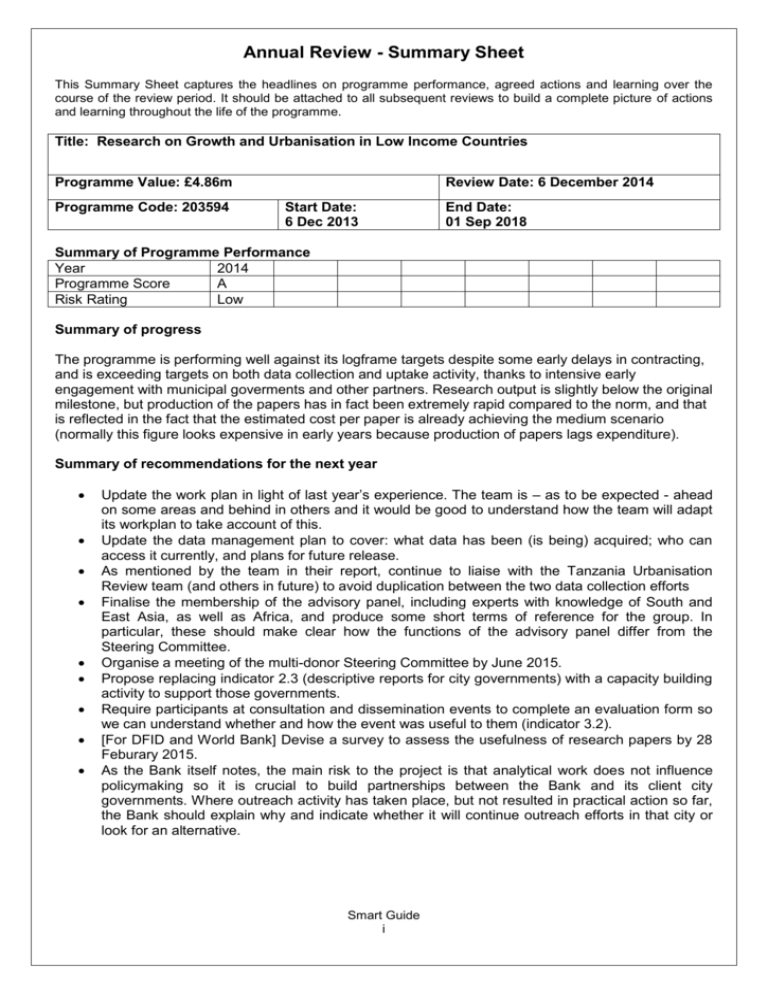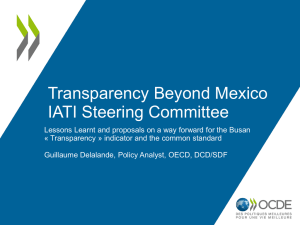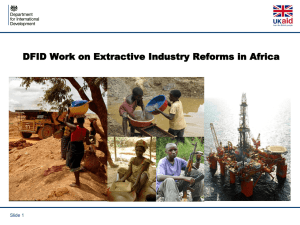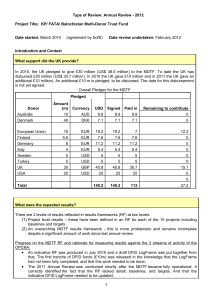D: VALUE FOR MONEY & FINANCIAL PERFORMANCE (1 page)
advertisement

Annual Review - Summary Sheet This Summary Sheet captures the headlines on programme performance, agreed actions and learning over the course of the review period. It should be attached to all subsequent reviews to build a complete picture of actions and learning throughout the life of the programme. Title: Research on Growth and Urbanisation in Low Income Countries Programme Value: £4.86m Programme Code: 203594 Review Date: 6 December 2014 Start Date: 6 Dec 2013 End Date: 01 Sep 2018 Summary of Programme Performance Year 2014 Programme Score A Risk Rating Low Summary of progress The programme is performing well against its logframe targets despite some early delays in contracting, and is exceeding targets on both data collection and uptake activity, thanks to intensive early engagement with municipal goverments and other partners. Research output is slightly below the original milestone, but production of the papers has in fact been extremely rapid compared to the norm, and that is reflected in the fact that the estimated cost per paper is already achieving the medium scenario (normally this figure looks expensive in early years because production of papers lags expenditure). Summary of recommendations for the next year Update the work plan in light of last year’s experience. The team is – as to be expected - ahead on some areas and behind in others and it would be good to understand how the team will adapt its workplan to take account of this. Update the data management plan to cover: what data has been (is being) acquired; who can access it currently, and plans for future release. As mentioned by the team in their report, continue to liaise with the Tanzania Urbanisation Review team (and others in future) to avoid duplication between the two data collection efforts Finalise the membership of the advisory panel, including experts with knowledge of South and East Asia, as well as Africa, and produce some short terms of reference for the group. In particular, these should make clear how the functions of the advisory panel differ from the Steering Committee. Organise a meeting of the multi-donor Steering Committee by June 2015. Propose replacing indicator 2.3 (descriptive reports for city governments) with a capacity building activity to support those governments. Require participants at consultation and dissemination events to complete an evaluation form so we can understand whether and how the event was useful to them (indicator 3.2). [For DFID and World Bank] Devise a survey to assess the usefulness of research papers by 28 Feburary 2015. As the Bank itself notes, the main risk to the project is that analytical work does not influence policymaking so it is crucial to build partnerships between the Bank and its client city governments. Where outreach activity has taken place, but not resulted in practical action so far, the Bank should explain why and indicate whether it will continue outreach efforts in that city or look for an alternative. Smart Guide i A. Introduction and Context (1 page) DevTrack er Link to Business Case: DevTrack er Link to Log frame: http://iati.dfid.gov.uk/iati_documents/4392718.d ocx http://iati.dfid.gov.uk/iati_documents/4533051.x ls Outline of the programme DFID is contributing £4.86m over 5 years to the expansion of a multi-donor trust fund for research organised by the World Bank, making use of European Space Agency spatial data and including eminent external researchers like Paul Collier, Tony Venables and Vernon Henderson. The aim of the programme will be to raise the profile of policy and investment choices linked to considerations of urbanization and growth amongst leaders and decision-makers formulating policy and strategy on economic development and growth. The programme’s findings would be disseminated through a series of World Bank-led engagements with senior policymakers, as well as independently via some of the Growth Research Team’s other programmes which are also studying the relationship between urbanisation and growth. The outcome we aim to achieve is to set consideration of cities and urban context issues right at the centre of decision making about economic development and growth. We will measure this by monitoring use of the programme’s data and analysis by the policy community, and also being used in new research funded independently of DFID. The ultimate impact of this improved understanding and awareness of urbanisation’s role in the growth process by decision makers will be better policies to manage the urbanisation process, enhancing growth, sustainability and poverty reduction. The programme will deliver the following outputs: 1. Increased availability of data to establish the facts about urbanisation in low-income countries: its extent, speed and character 2. More and better analysis of the determinants of the urbanisation process, its role in generating economic growth, and the link to poverty reduction. 3. Evaluation of the policy measures that could encourage faster or better urbanisation for poverty reduction. 4. Dissemination of the findings and dialogue with both national and city-level decisionmakers. The research agenda will begin by describing the structure of low-income cities: how dense are they? Are they ‘pyramids’ or ‘doughnuts’? It will then seek to understand why they evolved in the way that they did and how their structure affects current economic performance. Finally, with a full model of the city in hand the research can turn to predicting the effects of policy changes on economic performance and ultimately make recommendations for policy. The former Urban and Disaster Risk Management Department of the World Bank, now called the Social, Urban, Rural and Resilience Global Practice, is responsible for administration and management of the MDTF, including coordinating and reporting to the donors. For more details of the World Bank urban agenda, please refer to the link http://www.worldbank.org/en/results/2013/04/14/urban-development-results-profile. Smart Guide ii B: PERFORMANCE AND CONCLUSIONS (1-2 pages) Annual outcome assessment Although it is premature to make statements about the project’s success at outcome level, we do note that the programme is taking measures early on to increase the chances of policy uptake: the teams are working hard to build relationships with local governments which are also vital for constructive and efficient data collection efforts. Where the government collaborates in data collection, as it is already in some cases, it should increase the government’s feeling ownership of and trust in the ultimate findings. Overall output score and description The overall output score is A. The programme is performing well against its logframe targets despite some early delays in contracting, and is exceeding targets on both data collection and uptake activity, thanks to intensive early engagement with municipal goverments and other partners. Research output is slightly below the original milestone, but production of the papers has in fact been extremely rapid compared to the norm, and that is reflected in the fact that the estimated cost per paper is already achieving the medium scenario (normally this figure looks expensive in early years because production of papers lags expenditure). Key lessons In its first year the programme has learnt from the experience of procuring both data and analysis. While procurement of the centres of excellence took longer than expected, a thorough competititon helped to ensure value for money and the project has largely recovered its position. Procuring data has proved more costly than expected, and is a key point to monitor as the project proceeds. Key actions Key actions for the coming year include the roll-out of surveys in Dar es Salaam and Durban, and the identification of the next round of cities for the acquisition of satellite and local government data. Workshops with local government officials will continue as part of this process although no large-scale dissemination events are planned for this year. Descriptive reports should become available and some further analytical papers. Smart Guide iii C: DETAILED OUTPUT SCORING (1 page per output) Output Title Reliable datasets produced on spatial structure of economic activity at urban and national level Output number per LF 1 Output Score A Risk: Low Impact weighting (%): 20% Risk revised since last AR? N Impact weighting % revised since last AR? N Indicator(s) 1.1 Number of countries of the world for which geo-reference information on economic activity (nights light data) and other environmental characteristics is available 1.2 Number of developing country cities for which 2-3 years of highresolution satellite data on land use is available 1.3 Number of African cities for which new, geo-referenced household or firm-level surveys are available 1.4 Number of Chinese provinces for which geo-referenced economic, demographic and climatic data is available 1.5 No. of African countries for which sub-national level (district/province), on rural and urban populations, detailed climate, road access, soil quality Milestone (H/M/L) 0/0/0 Progress 3/2/1 4 2/1/0 0 0/0/0 0 0/0/0 0 0 Key Points This first year has largely involved scoping exercises in African cities to discover what data is available and where there is greatest willingness from policymakers to share information and collaborate. The team has held consultations with government (both city and national) and local research institutions in Nairobi, Addis Ababa, Dar es Salaam and Durban (indicator 1.3) and has already begun to roll out standards of living surveys in the latter two. In parallel, the team has acquired satellite images of Dar es Salaam, Nairobi, Addis Ababa and Kigali and has been trained in how to process the images (indicator 1.2). These data have a license for 5 users, shared between the Bank team and local government officials. The license will also allow the research team to disclose the raw data to local governments and NGOs without restriction. Some derived data will be made publically available through the German Aerospace Centre (dlr.de) and the European Commission’s Joint Research Centre (ec.europa.eu/jrc/). Further datasets will be acquired once the first batch has been analysed, and complementary province/district-level data will also be collected (indicator 1.5). Global and Chinese data collection (indicators 1.1 and 1.4) will begin later in the programme. The team has learnt a lot from the process of launching the first two living standards surveys. These surveys were based on a novel design – nothing exactly like them has been done before – and although they were put out to competition the prices tendered by private suppliers were much higher than anticipated. As such the team requested that we consider reducing the number of cities from the original 10 – see recommendations. Recommendations Smart Guide iv Update the work plan in light of last year’s experience. The team is – as to be expected - ahead on some areas and behind in others and it would be good to understand how the team will adapt its workplan to take account of this. To give two examples: o Surveys were envisaged in Dar es Salaam, Durban and Kigali. It seems that despite a mission to Kigali, data collection has not been agreed with the local government, so it would be good to know if it will take place in Kigali at a later date, or whether an alternative city will be substituted. o The workplan talks about a maximum of seven reports, whereas the agreed logframe is for a minimum of seven, maximum of 10. On this issue, maintain the logframe target of10 cities for new surveys (indicator 1.3) but take stock of how useful they are, given the costs involved. Update the data management plan to cover: what data has been (is being) acquired; who can access it currently, and plans for future release. As mentioned by the team in their report, continue to liaise with the Tanzania Urbanisation Review team (and others in future) to avoid duplication between the two data collection efforts Output Title High-quality, policy-relevant research produced on urbanisation in low-income countries Output number per LF 2 Output Score A Risk: Low Impact weighting (%): 50% Risk revised since last AR? N Impact weighting % revised since last AR? N Indicator(s) 2.1 Number of working papers published 2.2 Number of peer-reviewed journal articles accepted for publication 2.3 Number of reports on the evolution of urban form and economic activity in African cities Milestones (H/M/L) 15/10/5 2/1/0 Progress 2/1/0 0 3 0 Key Points Two working papers have been completed and are available online: “Housing Consumption and Urbanization”. Authors: Nancy Lozano-Gracia and Cheryl Young http://econ.worldbank.org/external/default/main?pagePK=64165259&theSitePK=469382&piPK=64 165421&menuPK=64166093&entityID=000158349_20141114150914 (World Bank Policy Research Working Paper No. 7112) “Urbanization and Housing Investment”. Authors: Basab Dasgupta, Somik V. Lall, and Nancy Lozano-Gracia http://econ.worldbank.org/external/default/main?pagePK=64165259&theSitePK=469382&piPK=64 165421&menuPK=64166093&entityID=000158349_20141113143922 (World Bank Policy Research Working Paper No. 7110) while a third has been drafted and presented at the North American Regional Science Council in November 2014 pending publication: “Correcting Overglow in Nighttime Lights Data”. Authors Alexei Abrahams, Nancy LozanoGracia, and Christopher Oram. Several other papers are advanced in the process of drafting, i.e. the analysis is essentially complete and findings largely written up but requires further review before they can be made public. The team had Smart Guide v agreed to a stretching target for research papers in its first year, and the procurement of the research institute that would carry out much of the work concluded later than expected – in June this year. As such, the outputs already completed have been produced by the World Bank in-house and reflect a high level of effort on their part. The key result from the two housing papers is that in low-income countries, household spending on housing is very low in almost all countries and for almost all income groups, and almost totally inadequate to consume a “decent” dwelling. This suggests that attempts to provide decent housing in a poor city are doomed to fail - better to invest in the productivity of the cities so that they will become middle income and then housing demand will take off naturally. The team has also assembled an advisory panel (referred to in the business case as the Technical Committee) which will ensure the analytical rigour and policy relevance of the research outputs. The panel involves World Bank staff and African officials and researchers. Recommendations Finalise the membership of the advisory panel, including experts with knowledge of South and East Asia, as well as Africa, and produce some short terms of reference for the group. In particular, these should make clear how the functions of the advisory panel differ from the Steering Committee. Organise a meeting of the multi-donor Steering Committee by June 2015. Propose replacing indicator 2.3 (descriptive reports for city governments) with a capacity building activity to support those governments. Output Title Policymakers guide choice of research topics and make use of research findings (uptake) Output number per LF 3 Output Score A Risk: Low Impact weighting (%): 30% Risk revised since last AR? N Impact weighting % revised since last AR? N Indicator(s) 3.1 Number of policy briefs produced, including one flagship report 3.2 Number of consultation and dissemination events attended by at least 20 senior stakeholders and rated "successful" or better by at least 50% of attendees 3.3 Number of participants at third-party research conferences that attend discussions of the programme's findings 3.4 Proportion of research papers (indicator 2.1) rated "relevant to policy" or better in a survey of stakeholders Milestones (H/M/L) 2/1/0 4/3/2 Progress 0/0/0 0 80% n/a 0 5 Key Points This programme has learnt from previous research projects that uptake activity should begin early, both to discover as many potential sources of data as possible and, crucially, to give the policy community the chance to shape the research questions that will be addressed. As such the team has been very active in the first year, holding consultation events in Kenya, Tanzania, Uganda, Rwanda, Ethiopia and South Africa. As a result, the team is already conducting surveys in Dar es Salaam and Durban where local researchers and officials are being invoved both in the survey design and the process of collecting data. Recommendations Smart Guide vi Require participants at consultation and dissemination events to complete an evaluation form so we can understand whether and how the event was useful to them (indicator 3.2). [For DFID and World Bank] Devise a survey to assess the usefulness of research papers by 28 Feburary 2015. As the Bank itself notes, the main risk to the project is that analytical work does not influence policymaking so it is crucial to build partnerships between the Bank and its client city governments. Where outreach activity has taken place, but not resulted in practical action so far, the Bank should explain why and indicate whether it will continue outreach efforts in that city or look for an alternative. D: VALUE FOR MONEY & FINANCIAL PERFORMANCE (1 page) Key cost drivers and performance As this is a multi-donor trust fund all monies are pooled. Therefore these comments are based on an indicative allocation of funds agreed between the Bank and DFID relating to the DFID contribution, rather than the trust fund as a whole. The majority of DFID funding will be used to pay for researcher time (46%) and data collection (34%), with smaller allocations for travel, equipment, dissemination events and materials, and management. VfM performance compared to the original VfM proposition in the business case The business case proposed two key cost-effectiveness metrics for this programme: the cost per paper produced (including journal articles and working papers), and the cost per paper achieving 10 or more citations. It is in reality too early to sensibly assess VFM performance against these metrics, but we provide the current state of the VFM metric for completeness – noting that expenditure normally leads output until the project concludes. VFM projections Cost per paper, £ 250,000 200,000 150,000 100,000 Paper 50,000 Actual to date L M H Scenario It is reassuring that on this crude metric the Bank is achieving its medium scenario – both because it reflects good VFM performance overall but also in this first year it indicates that the Bank is not buying data in advance of need. The Bank has shared concerns around the fact that survey bids are coming in much more expensive than anticipated, and DFID has asked the Bank to take stock of their usefulness relative to their cost. Assessment of whether the programme continues to represent value for money Smart Guide vii While the headline figures for this research programme were quite high i.e. the papers were relatively expensive due to the major data collection effort involved, the Bank has taken a conservative attitude to using DFID resources, both by making use of competitive tenders to let the analytical and data collection work at the most competitive rate, and by timing the purchase of data as late as possible. Leaving aside the metrics, there is real value added, though hard to measure, through thorough consultation with policymakers to ensure the research is addressing useful questions. The team has been very active on this front, and while it has paid for some such events, it has also participated in events funded by others e.g. the IGC conference in Kigali and we would encourage such cost sharing and collaboration with other programmes on uptake and outreach activity. Quality of financial management The World Bank mitigates financial and operational risks through strong internal controls and processes to safeguard donor assets. Controls are evaluated using the Committee of Sponsoring Organizations of the Treadway Commission (COSO), an internationally recognized and widely accepted internal control framework. Financial transactions are accounted for and recorded using appropriate accounting systems. The World Bank ensures proper and secure maintenance of all accounting documents and records for IDA and Trust Funds. Most of the donor funding received for IDA and Trust Funds is processed through the System for Tracking and Accounting for Resources (STAR). STAR is a customized, flexible interface that lowers transaction costs, enhances business controls and reduces operational and financial risk. Date of last narrative financial report Date of last audited annual statement 30 June 2014 30 June 2014 Donors are provided periodic financial reports through the World Bank’s Client Connection website (http://clientconnection.worldbank.org). At the end of each fiscal year, donors receive a Single Audit Report for all modified cash-basis trust funds, comprising (i) a management assertion together with an attestation signed by external auditors regarding effectiveness of internal controls over financial reporting of the modified cash-basis trust funds and (ii) a combined financial statement along with the external auditor’s report. E: RISK (½ page) Overall risk rating: Low Overview of programme risk The business case considered three categories of risk to this programme: 1. Management risk – factors that would prevent the research taking place, such as difficulty contracting staff or obtaining data. 2. Research risk – factors that would prevent the research from reaching firm or consistentn conclusions 3. Political risk – factors that would prevent the research findings having an influence on policymakers Many of the management risks have been resolved in the course of project start-up and the key risks to focus on going forward are research and political risks. Outstanding actions from risk assessment The main risk is that the analytic work does not inform and influence decision making. To mitigate this risk, the project will start by building partnerships between the Bank and key clients: the city governments and relevant national government agencies of the countries in which the focus cities are located. The anticipated research will require systematic information exchange and co-operation, and the Smart Guide viii results of the work will support city and national decision making around urban investment and policy. Initial dialogue has begun and will be deepened rapidly as the work gets underway. As results are generated, focused workshops and dissemination events will be held to ensure that the results feed into this process. Smart Guide ix F: COMMERCIAL CONSIDERATIONS (½ page) Delivery against planned timeframe The programme is slightly delayed relative to the planned timeframe, largely due to the procurement of a partner research consortium, the selection of which took longer than expected, concluding in June 2014. Other than this, and as is to be expected, the detail of some of what was planned did not work out as expected – this does not pose a serious problem but the team should update the work plans for next year to reflect this. Performance of partnership (s) The Multi-Donor Trust Fund for Sustainable Urban Development (MDTF SUD) was established in 2011 with a financial contribution of NOK 17.6 million (approximately USDUSD 2.9 million) from the Government of Norway payable in two tranches. In September 2013, SECO joined the MDTF and countersigned the grant agreement with a contribution of USD 9.8 million. DFID joined the MDTF in November 2013 with a contribution of GPB 4.682 million. H: MONITORING & EVALUATION (½ page) Somik V. Lall, Lead Urban Economist coordinates the monitoring and evaluation of the overall research program, as per World Bank’s guidelines. To enhance analytic rigor and policy relevance, an advisory group of leading academics, Bank staff, and policymakers will be formed. This group will meet three times during the life of the project and the team will seek bilateral feedback from various advisors. A preliminary list of advisors include Marianne Fay and Indermit Gill (peer reviewers), Danny Leipziger (Growth Dialogue), Richard Damania, Roland White (World Bank, Africa Region), Benno Ndulu (Central Bank Governor, Tanzania), Mthuli Ncube (Chief Economist AfDB), and Ann Bernstein (South African researcher). See also recommendations under output 2. Smart Guide x Smart Guide xi








